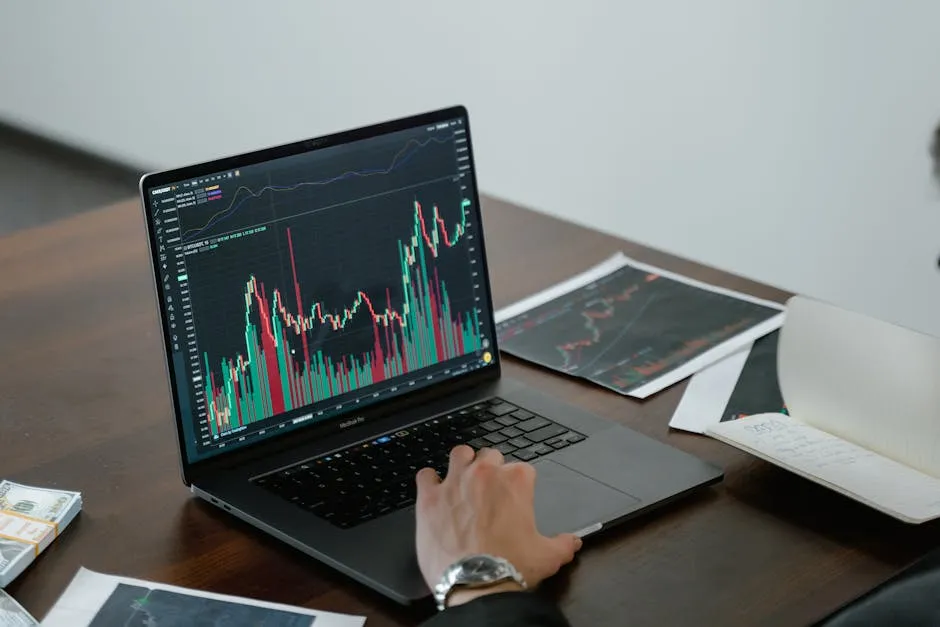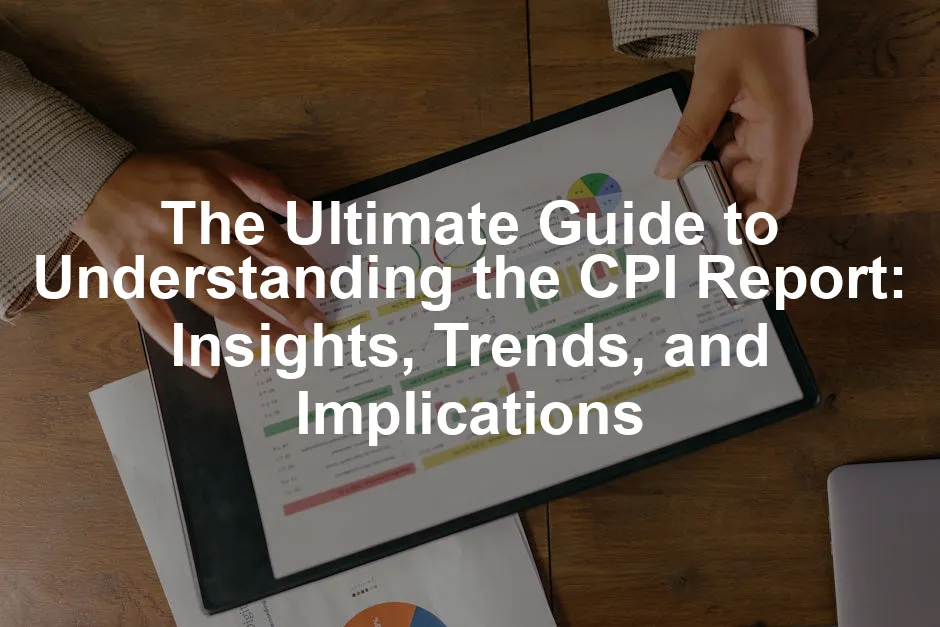Introduction
In today’s fast-paced economic environment, the Consumer Price Index (CPI) report is your wallet’s weather forecast. Just as a meteorologist helps you dodge raindrops, understanding CPI metrics keeps you ahead of financial storms. Whether it’s skyrocketing grocery bills or rental prices that make you feel like you’re being robbed, the CPI report gives you a snapshot of inflation that impacts your daily life. So, what exactly is this elusive CPI? It’s a statistical measure reflecting the average change over time in prices urban consumers pay for a basket of goods and services. Think of it as your personal inflation thermometer. If you’ve noticed your favorite coffee shop raising prices, the CPI has likely caught that too. But wait, there’s more! The CPI provides insights into broader economic trends. It’s not just about your morning latte; it reflects everything from housing costs to energy prices. This guide will unravel the intricacies of the CPI report, clarify what it means for your finances, and offer expert insights into upcoming trends. Now, let’s not beat around the bush. Understanding CPI can empower you to make well-informed financial decisions. As we navigate the twists and turns of inflation, having a grasp on CPI means you can manage your budget like a pro. So, buckle up; it’s time to get into the nitty-gritty of the CPI report!
Summary
The Consumer Price Index (CPI) report is a critical economic indicator reflecting price changes urban consumers experience for a basket of goods and services. This comprehensive guide will cover:- Definition and Significance: What is CPI? Why is it the go-to measure for inflation?
- Latest CPI Statistics: A look at month-to-month and year-over-year changes that matter.
- Key Components: The breakdown of CPI and its effects on sectors like housing, transportation, and energy.
- Implications of CPI Trends: How do these trends affect monetary policy and your spending habits?
- Upcoming CPI Releases: What to watch for in the next quarter.

Understanding the Consumer Price Index (CPI)
What is the CPI?
The Consumer Price Index (CPI) is a crucial measure of inflation. It tracks the average change in prices urban consumers pay over time for a basket of goods and services. This metric helps gauge the cost of living and economic health. Essentially, it’s like a report card for our wallets. So, what’s in this basket? The CPI basket includes common items like food, clothing, housing, and transportation. Prices for these items are collected regularly, providing a snapshot of how costs fluctuate. Think of it as the essential shopping list that reflects our daily lives. There are different types of CPI. The Core CPI excludes volatile items like food and energy, offering a clearer inflation picture. The CPIH includes housing costs, providing a more comprehensive view. Each type serves a unique purpose, catering to varied analytical needs.How is the CPI Calculated?
Calculating the CPI is no walk in the park; it’s a meticulous process. First, data is gathered through surveys from thousands of households across various geographic areas. This ensures a representative sample of consumer spending habits. Once the data is in, it’s all about weights. Different categories are weighted based on their significance in the average consumer’s budget. For example, housing costs are typically a larger portion of expenses compared to entertainment. This weighting is crucial, as it ensures the CPI accurately reflects the price changes most relevant to consumers.
Historical Context
Over the past decade, CPI trends have been quite the rollercoaster ride. From pre-pandemic stability to the dizzying heights of inflation post-COVID-19, understanding these shifts provides valuable insights into our economy. Significant events, like the pandemic, have dramatically influenced CPI, leading to sharp price increases in various sectors. Overall, recognizing these historical shifts helps contextualize current trends. It’s essential for consumers, businesses, and policymakers alike. By understanding the past, we can navigate future financial challenges with more confidence. If you want to delve deeper into the economic landscape, grab a copy of The Inflationary Universe: A Guide to the Economic Landscape. This book is perfect for anyone looking to understand the broader economic implications of inflation.
Current CPI Trends and Statistics
Regional Variations
The Consumer Price Index (CPI) doesn’t wear a one-size-fits-all shirt. Oh no, it varies greatly across different states and regions! Urban areas often see steeper price hikes compared to their rural counterparts. Why? Well, think about it—cities have more demand, and where there’s demand, prices tend to soar like a hot air balloon. Take California, for instance. The Golden State often experiences significant increases in housing costs. Meanwhile, rural areas in states like Nebraska might enjoy relatively stable prices. The CPI reflects these local economies. For example, in September 2024, the CPI for urban consumers in San Francisco rose 3.1%, while rural areas in Oklahoma saw only a 1.5% increase. Such discrepancies highlight how regional dynamics influence inflation. It’s like comparing apples to oranges—both fruit, but oh so different!
Long-term Trends
Inflation has been quite the drama queen lately, oscillating between pressure and relief. Over the past decade, we’ve witnessed inflationary pressures due to global events like energy crises. Remember when oil prices shot up? Yes, that definitely left a dent in many household budgets. Deflationary trends also have their moments. For instance, after the initial shock of the pandemic, we saw some prices stabilize. However, global supply chain issues have often kept inflation in the spotlight. In September 2024, the CPI indicated a year-over-year increase of 2.4%, largely fueled by rising energy costs. Each spike or dip tells a story about how interconnected our global economy is. So, whether it’s a pandemic or an energy crisis, local CPI reflects these global ripples like a mirror.
Future Outlook and Upcoming Releases
What to Expect in Upcoming CPI Reports
As we look ahead, the upcoming CPI reports promise to be quite the spectacle! The next quarter, particularly the October 2024 report, could bring some spicy surprises. Analysts are predicting a modest increase in the CPI, potentially hovering around 0.3%. This uptick could push the year-over-year inflation rate to approximately 2.6%. What might stir the economic pot? A few key factors could influence these trends. Supply chain disruptions are still lingering like that uninvited guest at a party. If manufacturers can’t source materials efficiently, prices will likely climb. Energy prices are another culprit. If crude oil continues its rollercoaster ride, we could see gas prices affect the CPI significantly.
Economic Indicators to Watch
While the CPI is a significant measure of inflation, it’s not the only player in town. Other economic indicators can provide valuable context, making them essential for a holistic analysis. One such indicator is the Producer Price Index (PPI). The PPI measures price changes from the perspective of the seller and can forecast future CPI movements. If producers face rising costs, those expenses often trickle down to consumers. The Unemployment Rate is another vital statistic to monitor. A low unemployment rate typically indicates a robust economy, which can drive consumer spending and, in turn, influence CPI. If more people are working, they’re more likely to spend money, putting upward pressure on prices. Lastly, let’s not overlook the importance of tracking wage growth. If wages rise, consumers may have more disposable income, which could lead to increased demand for goods and services. This uptick in demand could also fuel inflation, further impacting CPI.
Conclusion
In conclusion, the CPI report is more than just numbers; it’s a narrative about our economy and its direction. Understanding the fluctuations in consumer prices can help individuals, businesses, and policymakers navigate the economic landscape more effectively. The CPI sheds light on how rising costs affect our purchasing power. As inflation creeps up, consumers may find that their hard-earned dollars stretch less far. This situation can compel people to rethink their spending habits or even alter their lifestyle choices. For businesses, the implications are equally significant. Price changes can influence everything from inventory management to pricing strategies. Staying informed about CPI trends can provide a competitive edge in the marketplace. Policymakers also rely on CPI data to shape monetary policy. Central banks might adjust interest rates in response to rising inflation. Understanding these nuances is crucial for anyone looking to navigate the economic environment.
FAQs
The Consumer Price Index (CPI) is a crucial economic indicator reflecting price changes urban consumers experience for a basket of goods and services. For more detailed insights, you can check out this article on comparing economic indicators in memphis metropolitan statistical area vs national averages.What does the CPI measure?
The Consumer Price Index (CPI) measures changes in the price level of a basket of consumer goods and services purchased by households. It serves as a key indicator of inflation and helps gauge the cost of living. Essentially, it tracks how much more or less we need to spend to buy the same things over time. If the CPI rises, your dollar doesn’t stretch as far, which could mean fewer lattes or a smaller shopping cart.
How often is the CPI reported?
The CPI is reported monthly, with a comprehensive overview provided quarterly. Each month, the Bureau of Labor Statistics releases the latest CPI figures, showcasing how prices have fluctuated since the previous month. A quarterly report gives a broader view of price trends over a three-month period, allowing consumers and policymakers to see longer-term patterns.
What is the difference between CPI and Core CPI?
CPI includes all items, but Core CPI excludes food and energy prices, which can be volatile. Core CPI provides a clearer picture of underlying inflation trends. Since food and energy prices can swing wildly due to seasonality or geopolitical tensions, Core CPI helps economists and policymakers focus on long-term inflation trends without those dramatic fluctuations clouding the view.
How can consumers use CPI data?
Consumers can use CPI data to adjust their budgets and spending habits. By monitoring CPI trends, you can identify which categories are experiencing price hikes—like groceries or rent. This allows for smarter financial planning, such as cutting back on non-essentials during inflation spikes or seeking out deals in categories that are stable or declining in price.
Where can I find the latest CPI reports?
The latest CPI reports can be found on several reputable sources. The Bureau of Labor Statistics (BLS) provides detailed monthly reports on its website. For a broader economic context, Trading Economics and local government statistical agencies also release relevant data and insights. You can find the latest CPI figures, trends, and historical data at [BLS CPI Page](https://www.bls.gov/cpi/).
All images from Pexels




